Complete the sentences using verbs in the correct

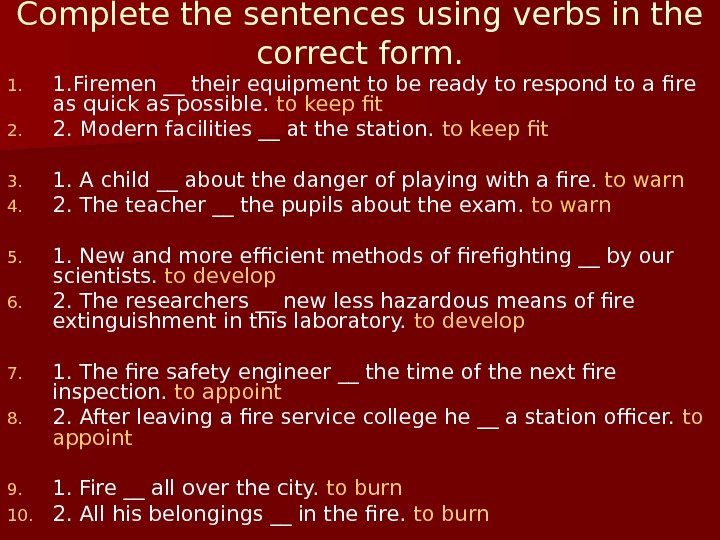
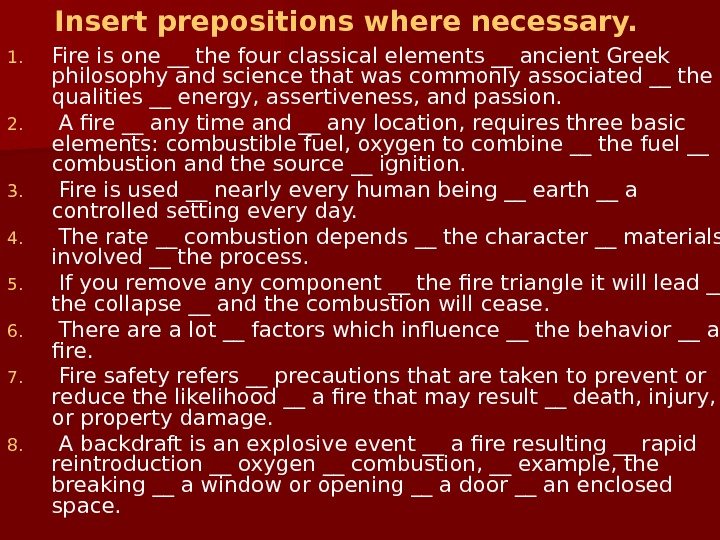
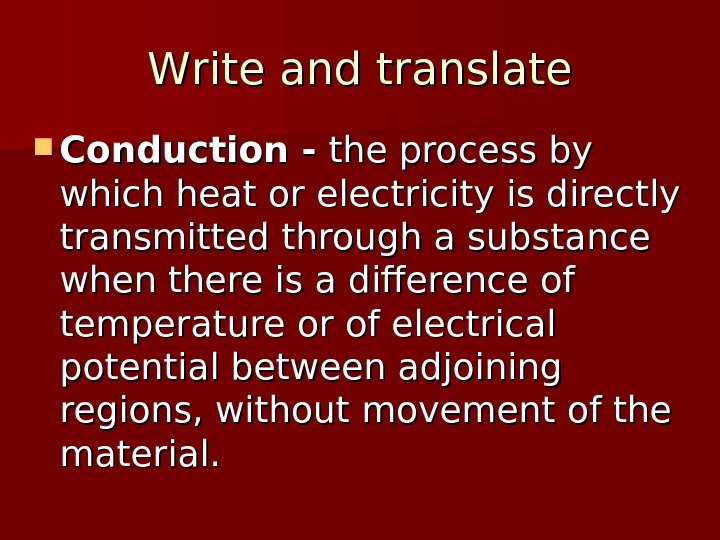
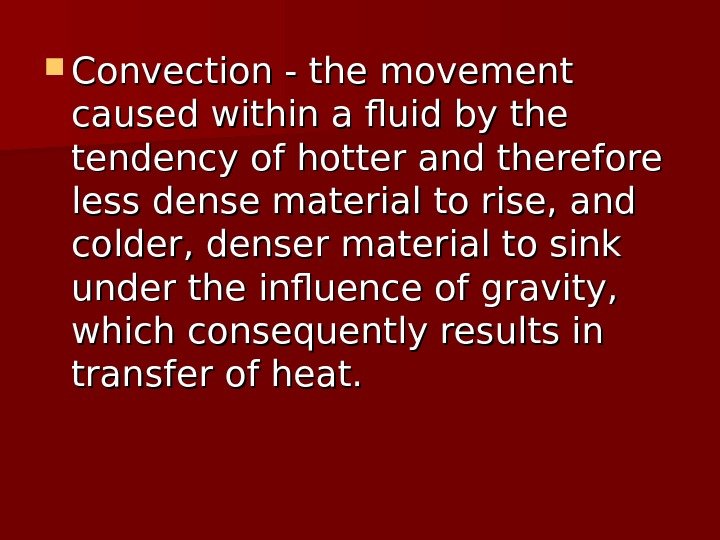
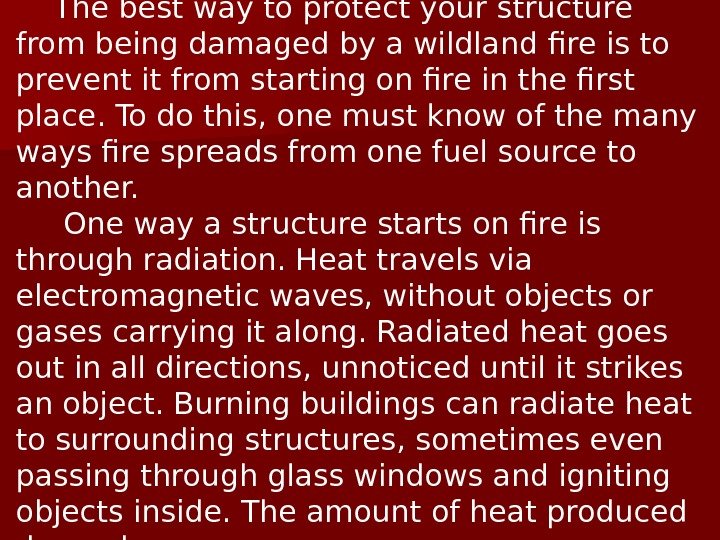
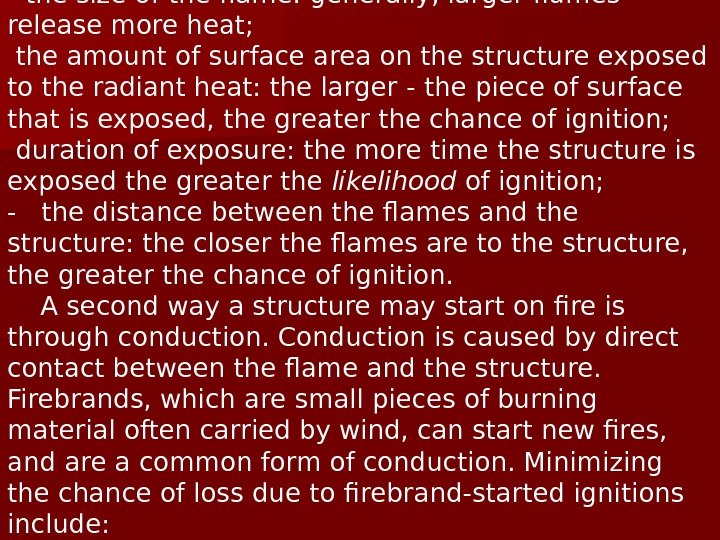
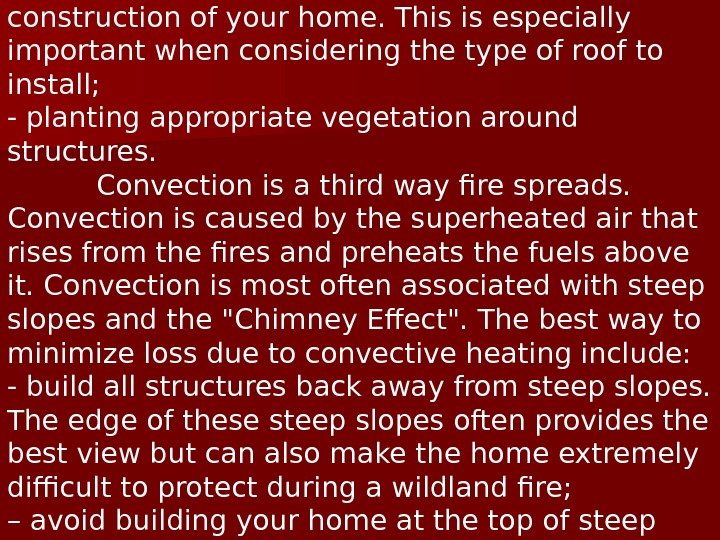
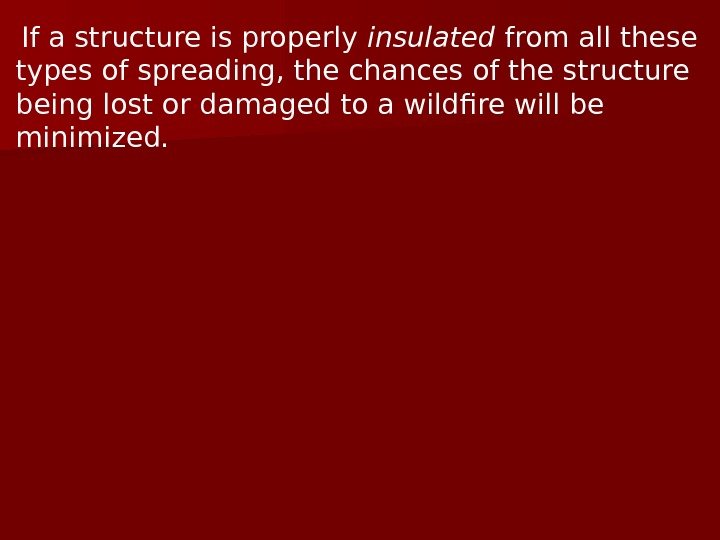
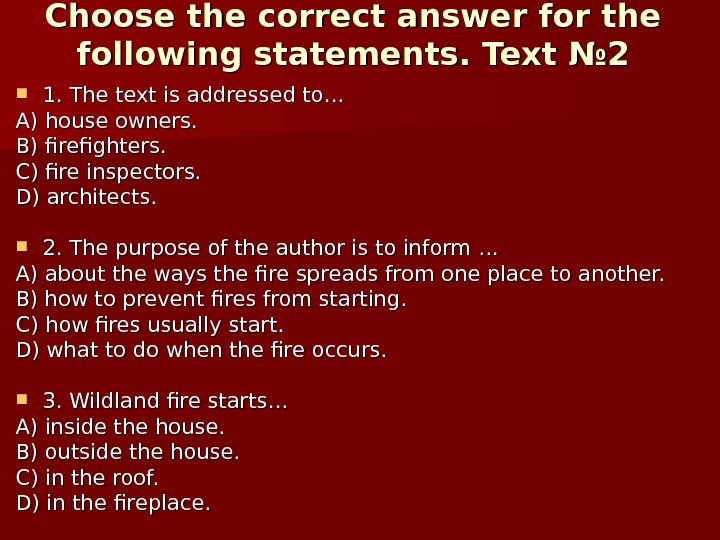
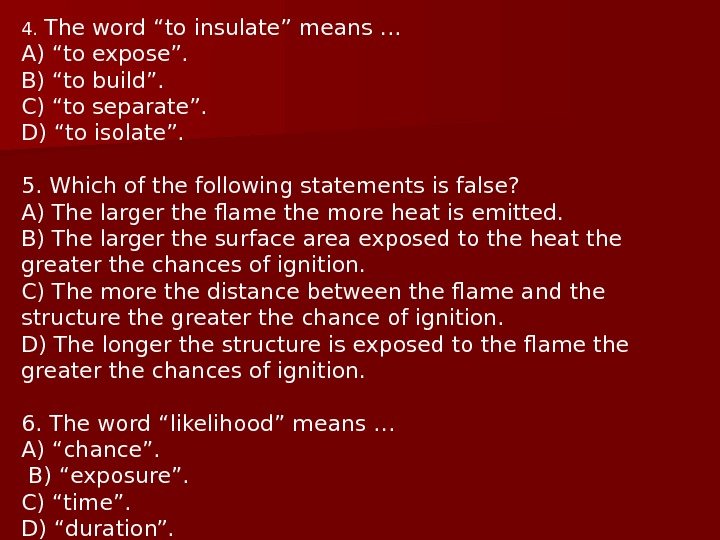
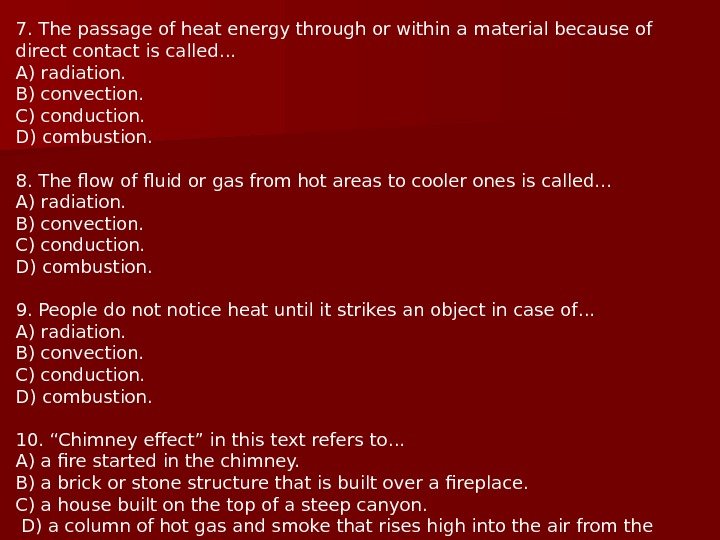
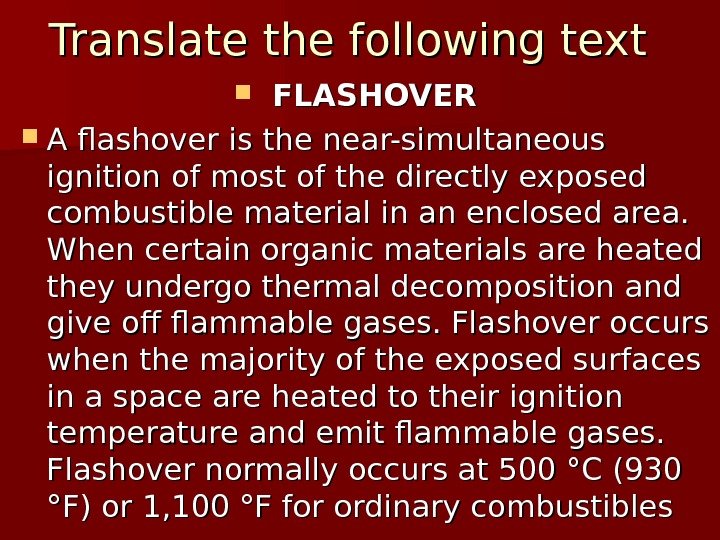
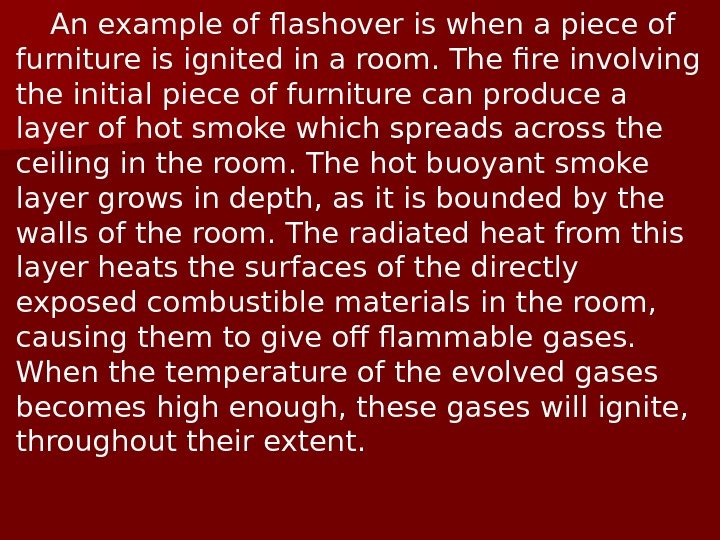
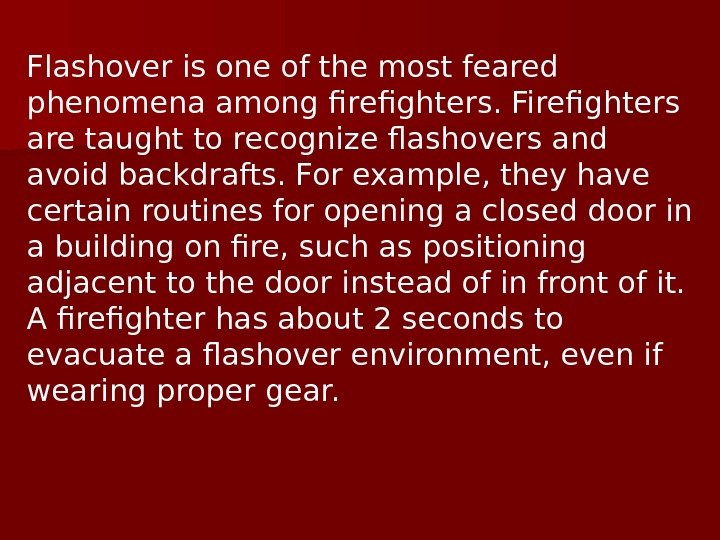
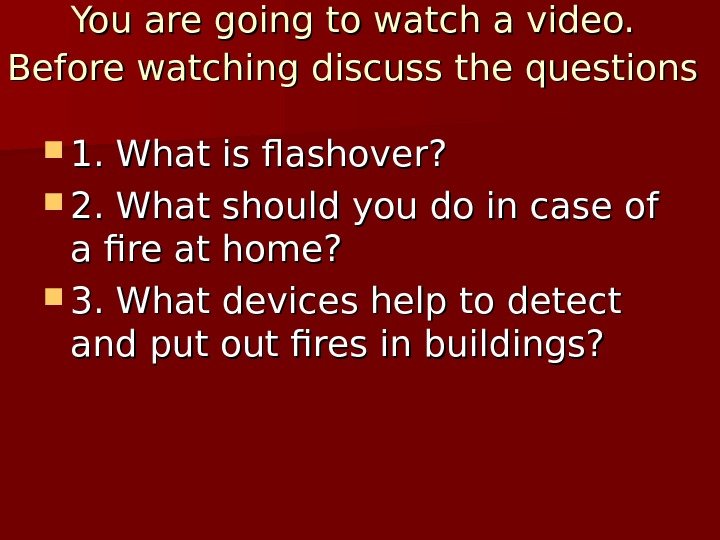

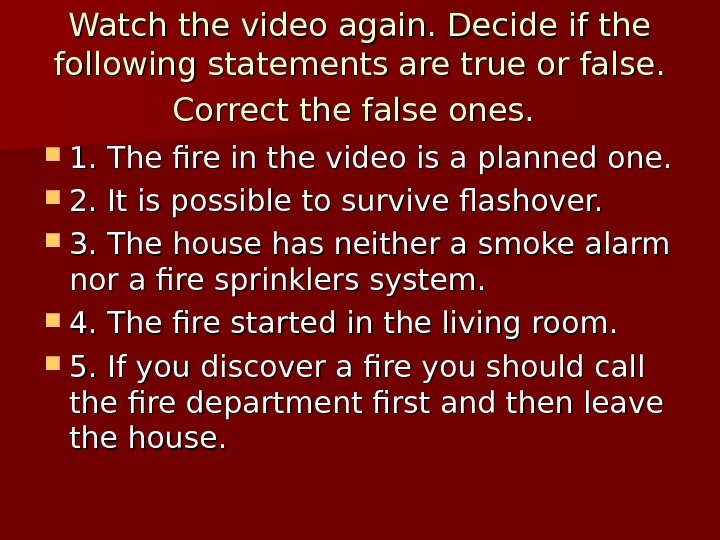
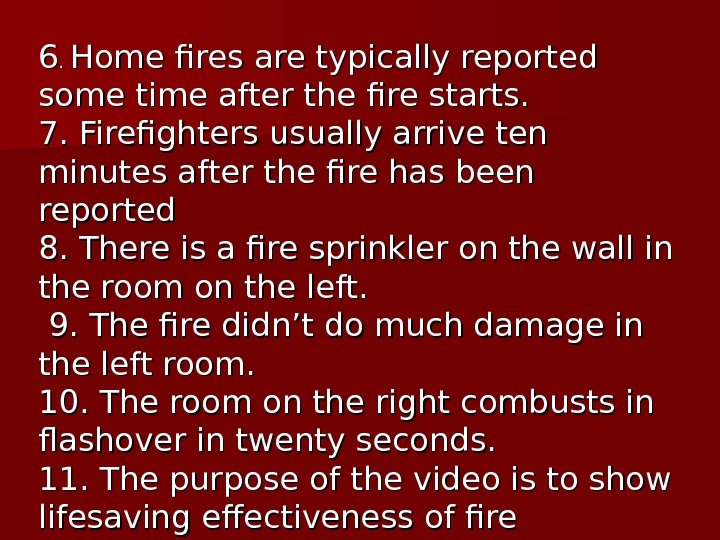
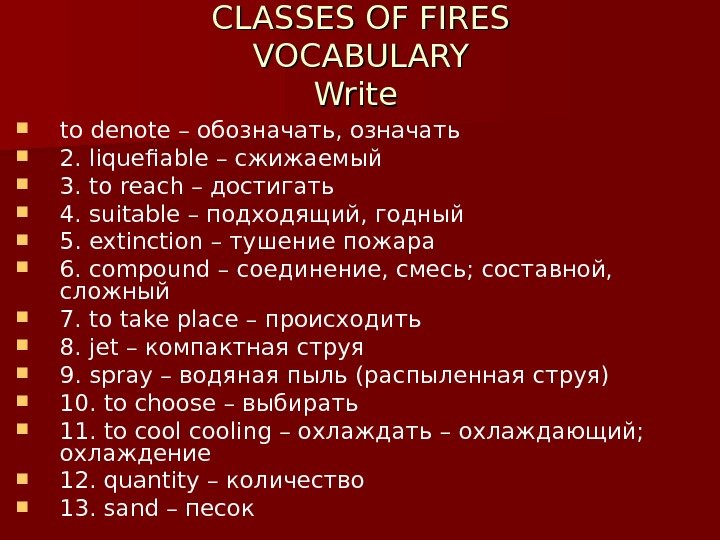
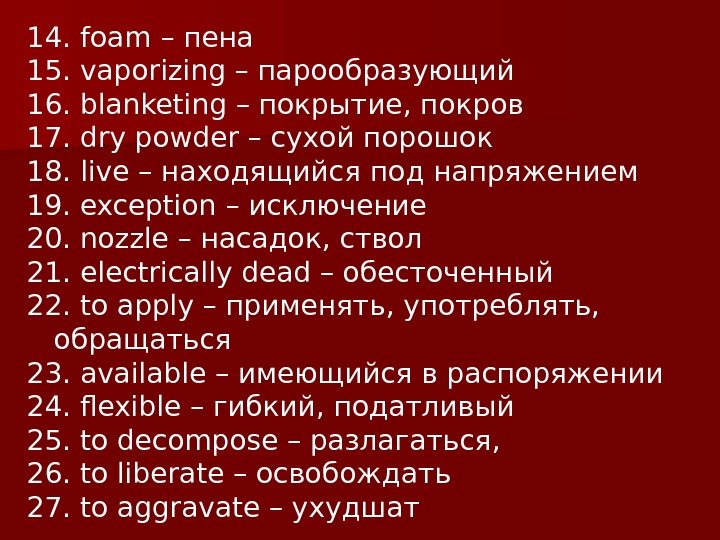
pogharnaya_bezopasnosty,_dopolnenie_k_uroku.ppt
- Размер: 111.0 Кб
- Автор:
- Количество слайдов: 20
Описание презентации Complete the sentences using verbs in the correct по слайдам
 Complete the sentences using verbs in the correct form. 1. 1. Firemen __ their equipment to be ready to respond to a fire as quick as possible. to keep fit 2. 2. Modern facilities __ at the station. to keep fit 3. 1. A child __ about the danger of playing with a fire. to warn 4. 2. The teacher __ the pupils about the exam. to warn 5. 1. New and more efficient methods of firefighting __ by our scientists. to develop 6. 2. The researchers __ new less hazardous means of fire extinguishment in this laboratory. to develop 7. 1. The fire safety engineer __ the time of the next fire inspection. to appoint 8. 2. After leaving a fire service college he __ a station officer. to appoint 9. 1. Fire __ all over the city. to burn 10. 2. All his belongings __ in the fire. to burn
Complete the sentences using verbs in the correct form. 1. 1. Firemen __ their equipment to be ready to respond to a fire as quick as possible. to keep fit 2. 2. Modern facilities __ at the station. to keep fit 3. 1. A child __ about the danger of playing with a fire. to warn 4. 2. The teacher __ the pupils about the exam. to warn 5. 1. New and more efficient methods of firefighting __ by our scientists. to develop 6. 2. The researchers __ new less hazardous means of fire extinguishment in this laboratory. to develop 7. 1. The fire safety engineer __ the time of the next fire inspection. to appoint 8. 2. After leaving a fire service college he __ a station officer. to appoint 9. 1. Fire __ all over the city. to burn 10. 2. All his belongings __ in the fire. to burn
 Insert prepositions where necessary. 1. Fire is one __ the four classical elements __ ancient Greek philosophy and science that was commonly associated __ the qualities __ energy, assertiveness, and passion. 2. A fire __ any time and __ any location, requires three basic elements: combustible fuel, oxygen to combine __ the fuel __ combustion and the source __ ignition. 3. Fire is used __ nearly every human being __ earth __ a controlled setting every day. 4. The rate __ combustion depends __ the character __ materials involved __ the process. 5. If you remove any component __ the fire triangle it will lead __ the collapse __ and the combustion will cease. 6. There a lot __ factors which influence __ the behavior __ a fire. 7. Fire safety refers __ precautions that are taken to prevent or reduce the likelihood __ a fire that may result __ death, injury, or property damage. 8. A backdraft is an explosive event __ a fire resulting __ rapid reintroduction __ oxygen __ combustion, __ example, the breaking __ a window or opening __ a door __ an enclosed space.
Insert prepositions where necessary. 1. Fire is one __ the four classical elements __ ancient Greek philosophy and science that was commonly associated __ the qualities __ energy, assertiveness, and passion. 2. A fire __ any time and __ any location, requires three basic elements: combustible fuel, oxygen to combine __ the fuel __ combustion and the source __ ignition. 3. Fire is used __ nearly every human being __ earth __ a controlled setting every day. 4. The rate __ combustion depends __ the character __ materials involved __ the process. 5. If you remove any component __ the fire triangle it will lead __ the collapse __ and the combustion will cease. 6. There a lot __ factors which influence __ the behavior __ a fire. 7. Fire safety refers __ precautions that are taken to prevent or reduce the likelihood __ a fire that may result __ death, injury, or property damage. 8. A backdraft is an explosive event __ a fire resulting __ rapid reintroduction __ oxygen __ combustion, __ example, the breaking __ a window or opening __ a door __ an enclosed space.
 WW rite and translate CC onduction — — the process by which heat or electricity is directly transmitted through a substance when there is a difference of temperature or of electrical potential between adjoining regions, without movement of the material.
WW rite and translate CC onduction — — the process by which heat or electricity is directly transmitted through a substance when there is a difference of temperature or of electrical potential between adjoining regions, without movement of the material.
 Convection — the movement caused within a fluid by the tendency of hotter and therefore less dense material to rise, and colder, denser material to sink under the influence of gravity, which consequently results in transfer of heat.
Convection — the movement caused within a fluid by the tendency of hotter and therefore less dense material to rise, and colder, denser material to sink under the influence of gravity, which consequently results in transfer of heat.
 PROTECT YOUR HOME The best way to protect your structure from being damaged by a wildland fire is to prevent it from starting on fire in the first place. To do this, one must know of the many ways fire spreads from one fuel source to another. One way a structure starts on fire is through radiation. Heat travels via electromagnetic waves, without objects or gases carrying it along. Radiated heat goes out in all directions, unnoticed until it strikes an object. Burning buildings can radiate heat to surrounding structures, sometimes even passing through glass windows and igniting objects inside. The amount of heat produced depends on:
PROTECT YOUR HOME The best way to protect your structure from being damaged by a wildland fire is to prevent it from starting on fire in the first place. To do this, one must know of the many ways fire spreads from one fuel source to another. One way a structure starts on fire is through radiation. Heat travels via electromagnetic waves, without objects or gases carrying it along. Radiated heat goes out in all directions, unnoticed until it strikes an object. Burning buildings can radiate heat to surrounding structures, sometimes even passing through glass windows and igniting objects inside. The amount of heat produced depends on:
 — the size of the flame: generally, larger flames release more heat; the amount of surface area on the structure exposed to the radiant heat: the larger — the piece of surface that is exposed, the greater the chance of ignition; duration of exposure: the more time the structure is exposed the greater the likelihood of ignition; — the distance between the flames and the structure: the closer the flames are to the structure, the greater the chance of ignition. A second way a structure may start on fire is through conduction. Conduction is caused by direct contact between the flame and the structure. Firebrands, which are small pieces of burning material often carried by wind, can start new fires, and are a common form of conduction. Minimizing the chance of loss due to firebrand-started ignitions include:
— the size of the flame: generally, larger flames release more heat; the amount of surface area on the structure exposed to the radiant heat: the larger — the piece of surface that is exposed, the greater the chance of ignition; duration of exposure: the more time the structure is exposed the greater the likelihood of ignition; — the distance between the flames and the structure: the closer the flames are to the structure, the greater the chance of ignition. A second way a structure may start on fire is through conduction. Conduction is caused by direct contact between the flame and the structure. Firebrands, which are small pieces of burning material often carried by wind, can start new fires, and are a common form of conduction. Minimizing the chance of loss due to firebrand-started ignitions include:
 – using non-flammable building materials in the construction of your home. This is especially important when considering the type of roof to install; — planting appropriate vegetation around structures. Convection is a third way fire spreads. Convection is caused by the superheated air that rises from the fires and preheats the fuels above it. Convection is most often associated with steep slopes and the «Chimney Effect». The best way to minimize loss due to convective heating include: — build all structures back away from steep slopes. The edge of these steep slopes often provides the best view but can also make the home extremely difficult to protect during a wildland fire; – avoid building your home at the top of steep canyons.
– using non-flammable building materials in the construction of your home. This is especially important when considering the type of roof to install; — planting appropriate vegetation around structures. Convection is a third way fire spreads. Convection is caused by the superheated air that rises from the fires and preheats the fuels above it. Convection is most often associated with steep slopes and the «Chimney Effect». The best way to minimize loss due to convective heating include: — build all structures back away from steep slopes. The edge of these steep slopes often provides the best view but can also make the home extremely difficult to protect during a wildland fire; – avoid building your home at the top of steep canyons.
 If a structure is properly insulated from all these types of spreading, the chances of the structure being lost or damaged to a wildfire will be minimized.
If a structure is properly insulated from all these types of spreading, the chances of the structure being lost or damaged to a wildfire will be minimized.
 Choose the correct answer for the following statements. Text № 2№ 2 1. The text is addressed to… A) house owners. B) firefighters. C) fire inspectors. D) architects. 2. The purpose of the author is to inform … A) about the ways the fire spreads from one place to another. B) how to prevent fires from starting. C) how fires usually start. D) what to do when the fire occurs. 3. Wildland fire starts… A) inside the house. B) outside the house. C) in the roof. D) in the fireplace.
Choose the correct answer for the following statements. Text № 2№ 2 1. The text is addressed to… A) house owners. B) firefighters. C) fire inspectors. D) architects. 2. The purpose of the author is to inform … A) about the ways the fire spreads from one place to another. B) how to prevent fires from starting. C) how fires usually start. D) what to do when the fire occurs. 3. Wildland fire starts… A) inside the house. B) outside the house. C) in the roof. D) in the fireplace.
 4. The word “to insulate” means … A) “to expose”. B) “to build”. C) “to separate”. D) “to isolate”. 5. Which of the following statements is false? A) The larger the flame the more heat is emitted. B) The larger the surface area exposed to the heat the greater the chances of ignition. C) The more the distance between the flame and the structure the greater the chance of ignition. D) The longer the structure is exposed to the flame the greater the chances of ignition. 6. The word “likelihood” means … A) “chance”. B) “exposure”. C) “time”. D) “duration”.
4. The word “to insulate” means … A) “to expose”. B) “to build”. C) “to separate”. D) “to isolate”. 5. Which of the following statements is false? A) The larger the flame the more heat is emitted. B) The larger the surface area exposed to the heat the greater the chances of ignition. C) The more the distance between the flame and the structure the greater the chance of ignition. D) The longer the structure is exposed to the flame the greater the chances of ignition. 6. The word “likelihood” means … A) “chance”. B) “exposure”. C) “time”. D) “duration”.
 7. The passage of heat energy through or within a material because of direct contact is called… A) radiation. B) convection. C) conduction. D) combustion. 8. The flow of fluid or gas from hot areas to cooler ones is called… A) radiation. B) convection. C) conduction. D) combustion. 9. People do notice heat until it strikes an object in case of… A) radiation. B) convection. C) conduction. D) combustion. 10. “Chimney effect” in this text refers to… A) a fire started in the chimney. B) a brick or stone structure that is built over a fireplace. C) a house built on the top of a steep canyon. D) a column of hot gas and smoke that rises high into the air from the fire.
7. The passage of heat energy through or within a material because of direct contact is called… A) radiation. B) convection. C) conduction. D) combustion. 8. The flow of fluid or gas from hot areas to cooler ones is called… A) radiation. B) convection. C) conduction. D) combustion. 9. People do notice heat until it strikes an object in case of… A) radiation. B) convection. C) conduction. D) combustion. 10. “Chimney effect” in this text refers to… A) a fire started in the chimney. B) a brick or stone structure that is built over a fireplace. C) a house built on the top of a steep canyon. D) a column of hot gas and smoke that rises high into the air from the fire.
 Translate the following text FLASHOVER A flashover is the near-simultaneous ignition of most of the directly exposed combustible material in an enclosed area. When certain organic materials are heated they undergo thermal decomposition and give off flammable gases. Flashover occurs when the majority of the exposed surfaces in a space are heated to their ignition temperature and emit flammable gases. Flashover normally occurs at 500 °C (930 °F) or 1, 100 °F for ordinary combustibles
Translate the following text FLASHOVER A flashover is the near-simultaneous ignition of most of the directly exposed combustible material in an enclosed area. When certain organic materials are heated they undergo thermal decomposition and give off flammable gases. Flashover occurs when the majority of the exposed surfaces in a space are heated to their ignition temperature and emit flammable gases. Flashover normally occurs at 500 °C (930 °F) or 1, 100 °F for ordinary combustibles
 An example of flashover is when a piece of furniture is ignited in a room. The fire involving the initial piece of furniture can produce a layer of hot smoke which spreads across the ceiling in the room. The hot buoyant smoke layer grows in depth, as it is bounded by the walls of the room. The radiated heat from this layer heats the surfaces of the directly exposed combustible materials in the room, causing them to give off flammable gases. When the temperature of the evolved gases becomes high enough, these gases will ignite, throughout their extent.
An example of flashover is when a piece of furniture is ignited in a room. The fire involving the initial piece of furniture can produce a layer of hot smoke which spreads across the ceiling in the room. The hot buoyant smoke layer grows in depth, as it is bounded by the walls of the room. The radiated heat from this layer heats the surfaces of the directly exposed combustible materials in the room, causing them to give off flammable gases. When the temperature of the evolved gases becomes high enough, these gases will ignite, throughout their extent.
 Flashover is one of the most feared phenomena among firefighters. Firefighters are taught to recognize flashovers and avoid backdrafts. For example, they have certain routines for opening a closed door in a building on fire, such as positioning adjacent to the door instead of in front of it. A firefighter has about 2 seconds to evacuate a flashover environment, even if wearing proper gear.
Flashover is one of the most feared phenomena among firefighters. Firefighters are taught to recognize flashovers and avoid backdrafts. For example, they have certain routines for opening a closed door in a building on fire, such as positioning adjacent to the door instead of in front of it. A firefighter has about 2 seconds to evacuate a flashover environment, even if wearing proper gear.
 You are going to watch a video. Before watching discuss the questions 1. What is flashover? 2. What should you do in case of a fire at home? 3. What devices help to detect and put out fires in buildings?
You are going to watch a video. Before watching discuss the questions 1. What is flashover? 2. What should you do in case of a fire at home? 3. What devices help to detect and put out fires in buildings?

 Watch the video again. Decide if the following statements are true or false. Correct the false ones. 1. The fire in the video is a planned one. 2. It is possible to survive flashover. 3. The house has neither a smoke alarm nor a fire sprinklers system. 4. The fire started in the living room. 5. If you discover a fire you should call the fire department first and then leave the house.
Watch the video again. Decide if the following statements are true or false. Correct the false ones. 1. The fire in the video is a planned one. 2. It is possible to survive flashover. 3. The house has neither a smoke alarm nor a fire sprinklers system. 4. The fire started in the living room. 5. If you discover a fire you should call the fire department first and then leave the house.
 66. . Home fires are typically reported some time after the fire starts. 77. Firefighters usually arrive ten minutes after the fire has been reported 88. There is a fire sprinkler on the wall in the room on the left. 99. The fire didn’t do much damage in the left room. 11 00. The room on the right combusts in flashover in twenty seconds. 11 11. The purpose of the video is to show lifesaving effectiveness of fire sprinklers.
66. . Home fires are typically reported some time after the fire starts. 77. Firefighters usually arrive ten minutes after the fire has been reported 88. There is a fire sprinkler on the wall in the room on the left. 99. The fire didn’t do much damage in the left room. 11 00. The room on the right combusts in flashover in twenty seconds. 11 11. The purpose of the video is to show lifesaving effectiveness of fire sprinklers.
 CLASSES OF FIRES VOCABULARY Write to denote – обозначать, означать 2. liquefiable – сжижаемый 3. to reach – достигать 4. suitable – подходящий, годный 5. extinction – тушение пожара 6. compound – соединение, смесь; составной, сложный 7. to take place – происходить 8. jet – компактная струя 9. spray – водяная пыль (распыленная струя) 10. to choose – выбирать 11. to cooling – охлаждать – охлаждающий; охлаждение 12. quantity – количество 13. sand – песок
CLASSES OF FIRES VOCABULARY Write to denote – обозначать, означать 2. liquefiable – сжижаемый 3. to reach – достигать 4. suitable – подходящий, годный 5. extinction – тушение пожара 6. compound – соединение, смесь; составной, сложный 7. to take place – происходить 8. jet – компактная струя 9. spray – водяная пыль (распыленная струя) 10. to choose – выбирать 11. to cooling – охлаждать – охлаждающий; охлаждение 12. quantity – количество 13. sand – песок
 14. foam – пена 15. vaporizing – парообразующий 16. blanketing – покрытие, покров 17. dry powder – сухой порошок 18. live – находящийся под напряжением 19. exception – исключение 20. nozzle – насадок, ствол 21. electrically dead – обесточенный 22. to apply – применять, употреблять, обращаться 23. available – имеющийся в распоряжении 24. flexible – гибкий, податливый 25. to decompose – разлагаться, 26. to liberate – освобождать 27. to aggravate – ухудшат
14. foam – пена 15. vaporizing – парообразующий 16. blanketing – покрытие, покров 17. dry powder – сухой порошок 18. live – находящийся под напряжением 19. exception – исключение 20. nozzle – насадок, ствол 21. electrically dead – обесточенный 22. to apply – применять, употреблять, обращаться 23. available – имеющийся в распоряжении 24. flexible – гибкий, податливый 25. to decompose – разлагаться, 26. to liberate – освобождать 27. to aggravate – ухудшат

